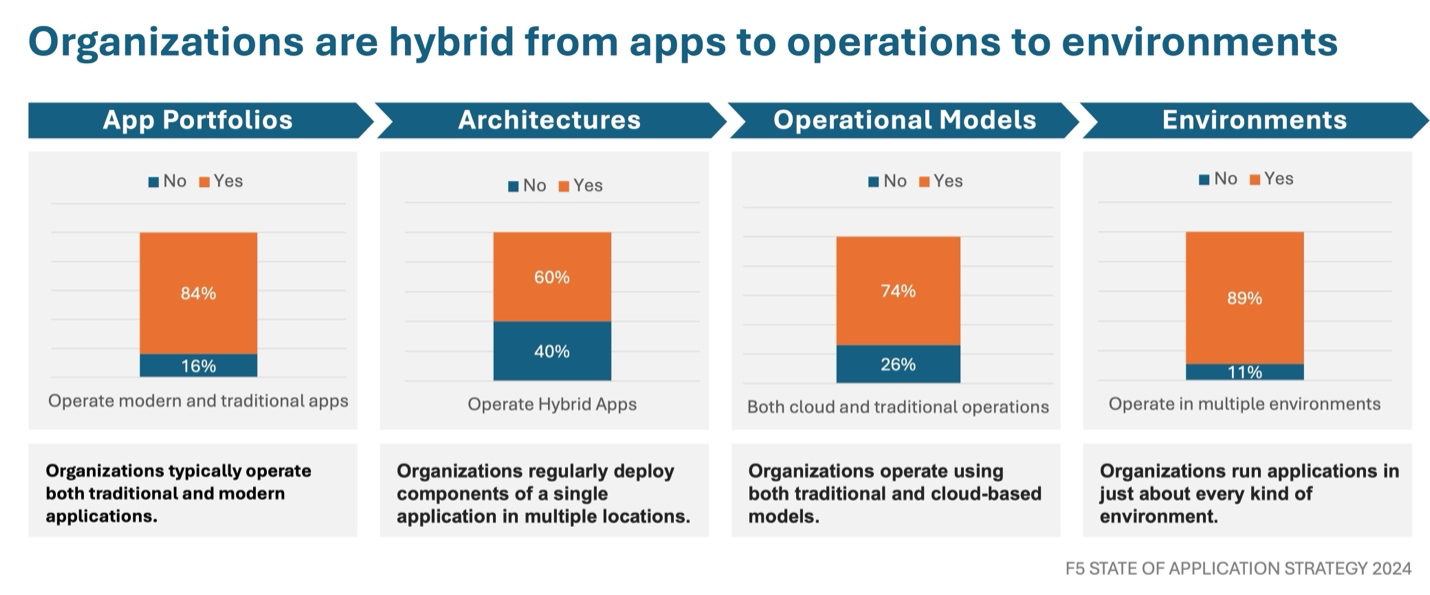State of Application Strategy 2024: Exploring Hybrid IT Trends
If marketing hype means anything, then the industry has accepted that the enterprise, for the most part, is hybrid.
Hybrid is a loaded term, much like cloud and edge and even AI. But in general, we use hybrid to mean “something comprised of two different somethings.” If you prefer, substitute ‘heterogeneous’ for ‘hybrid’ and it pretty much means the same thing.
For example, a hybrid application portfolio means that the set of applications under management by an organization is inclusive of both modern (mobile, microservices) and traditional (client-server, monoliths, three-tier web) applications.
We apply this same terminology to other aspects of the enterprise, such as architectures, operations, and even the environments in which organizations choose to deploy and operate applications.
Why is it important to recognize hybrid things? Because hybrid anything brings especial challenges to the fore that aren’t present when you’re just developing, deploying, operating, or securing a single “thing.” The consequences of heterogeneous anything are different teams, tools, practices, and processes.
And that, kids, is where complexity comes from.
This is exactly the state of the typical enterprise today. Overwhelmed by the complexity of being hybrid while recognizing that being hybrid is a given for the foreseeable future.
When we look at the typical enterprise through this lens, we find that organizations are absolutely, staunchly, and most definitely hybrid no matter which aspect we’re looking at.

From app portfolios to architectures, from operational models to environments, every enterprise is grappling with the challenges of at least one kind of heterogeneity—and usually more.
Hybrid impacts everything about an enterprise, from strategy to execution. It engenders interest in technologies and trends that are, at their core, about solving the complexity that arises from operating heterogeneous infrastructure, applications, and operations.
Respondents who told us they had multiple components of a single application running in multiple clouds were more likely to be excited about technologies like GraphQL, microservices networking, and large language models (LLMs). They were also more excited about multicloud networking, IT centralization, and supercloud; all trends that are focused on solving the complexity of connecting, securing, and managing the modern distributed enterprise.
Complexity of tools and APIs is nearly a ubiquitous challenge, with 94% of respondents this year reporting it is the singular most frustrating challenge they face with multicloud. But complexity from heterogeneity appears elsewhere, with more than half (52%) of respondents citing complexity of tooling as a barrier to automation of app delivery and security. Consider that we track deployment of 30 distinct application services from network security to CDNs to VDI to SSL VPNs. Each one of those has an average deployment rate of 93%. That means 93% of all respondents have deployed each of those thirty app services.
They don’t all interoperate; in fact, many are in completely different domains with different approaches to operations and management. That’s the reality of hybrid. It was always there, under the shiny application exterior, waiting to be exposed by digital transformation.
There is no escaping hybrid, unless you go “all in” on one public cloud that can provide every service necessary to operate, deliver, and secure applications. We don’t see that taking off as a trend. Only 2% of organizations are “all in” and of those, only 34% have tied their fortunes to a single cloud provider. Those in an all-in-one-public-cloud basket are outliers.
Organizations are distributed, multicloud, hybrid estates.
That means traditional solutions must also become distributed, multicloud, hybrid services that can truly deliver, secure, and optimize every app and API, everywhere.
You can read more about hybrid IT and its challenges, including how organizations are responding, in our State of Application Strategy 2024 report.
